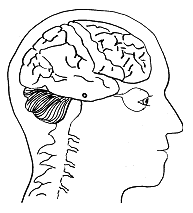|
Neural Priming
|
|
|
|
|
|
Neural Priming |
|
|
|
A Key Factor in Less Neural
Effort PART III Repetition Neural Priming and the Cerebellum’s Role in Skill-Building Common experience shows us that many things are easier the second time around. Neuroscience research is able to use fMRI to map the neural changes that occur when an initial stimulus is later repeated. Recognition (i.e., learning) improves with a single repetition, while the magnitude of neural response to the repeated stimulus deceases. (1) This conservation of neural energy is considered a good indicator that the brain has “learned” something new. There is good evidence that this greater magnitude of neural activity that is observed when a novel stimulus is presented is related to a survival mechanism that creates an urgency to determine if the new stimulus is “friend or foe”. (2) This heightened alertness is an asset for triggering initial attention, but a handicap once the learning process progresses into habit formation. The learning process, whether it is learning to walk again after physical trauma or learning to read, requires (a) an initial burst of neural response indicative of focused alertness, followed by (b) reduced neural attention when the stimulus is repeated. This reduced neural priming is part of the brain’s energy efficient process of automating repeated responses to old (safe) stimuli so it can expend more neural energy on new stimuli. Learning and skill acquisition is accomplished by accumulating new responses into old habits. More specifically, the process of successful skill building happens through automaticity of sequenced learning. The brain does this in part by shifting the location of responding to recognized (learned) stimuli from the cerebrum to the cerebellum. The cerebellum is largely responsibility for reproducing sequences of neural activity that can represent habitual movements, cognitive processes or emotional reactions. The cerebellum does this with much less expenditure of neural activity than it takes the cerebrum to create the neural response. This is why habits, for better or worse, are easy to repeat and difficult to extinguish. The Infinity Walk method was designed to take advantage of the brain’s heightened neural priming response to the new stimuli, and, its energy conserving use of sequenced neural habits. Infinity Walk method carefully adds new challenges to a progression of a multitude of repeated neural responses that occur along its figure-eight circuit. The clinician who facilitates an Infinity Walker can observe shifts in the fluidness of movement as the Infinity Walker’s brain responds to fluctuations in neural activity.
Improved balance and coordination, ease of breathing and speaking, and so on, are some of the indicators that cerebral neural activity has decreased (calmed down) and a new skill level has been integrated into a more automated neural habit under the control of the cerebellum. The facilitating clinician adds the next relevant challenge to Infinity Walk training after the Infinity Walker’s body demonstrates the transition to a more naturally rhythmic movement (cerebellum), leaving the cerebral cortex ready to process new input. Clinical skill in facilitating the optimal timing of adding new challenges to Infinity Walk training comes with practice and experience. To learn more about this topic, read Deborah Sunbeck’s 2002 text, Infinity Walk: BOOK I: The Physical Self. |
|
(1) Martin, A. and Gotta, S.J. Making the causal link: frontal cortex
activity and repetition priming. Nature Neuroscience, Vol. 8, No. 9.,
September 2005. (2) Leavengood A, Weekes N The association between stress, hemispheric specialization, and callosal interactions. Brain Cognition 2000 Jun-Au;4391-3):306-10. The corpus callosum responds to stress by becoming more active. In fact, individuals who report a greater state of anxiety seem to have an more efficient callosal transfer than those who report less anxiety. Though prior research is in agreement that the two hemispheres are asymmetric in their regulation and response to stress, this finding that more activity occurs across hemisphere under stress suggest that both hemispheres involve themselves in this regulation and response. This research also supports the current hypothesis that the right hemispheres kick in under unusual circumstances and shows united support across the corpus callosum.
(3) Diamond A. Close interrelation of motor development and cognitive
development and of the cerebellum and prefrontal cortex. Child
Development 2000 Jan-Feb;71(1):44-56. |
|
|
Leonardo Foundation Press 151 Panorama Trail Rochester, New York USA 14625-1843 info@infinitywalk.org Copyright © Sunbeck, All Rights Reserved Infinity Walk® and Infinity WalkAbout® are US Trademark & Patent Protected |
|

